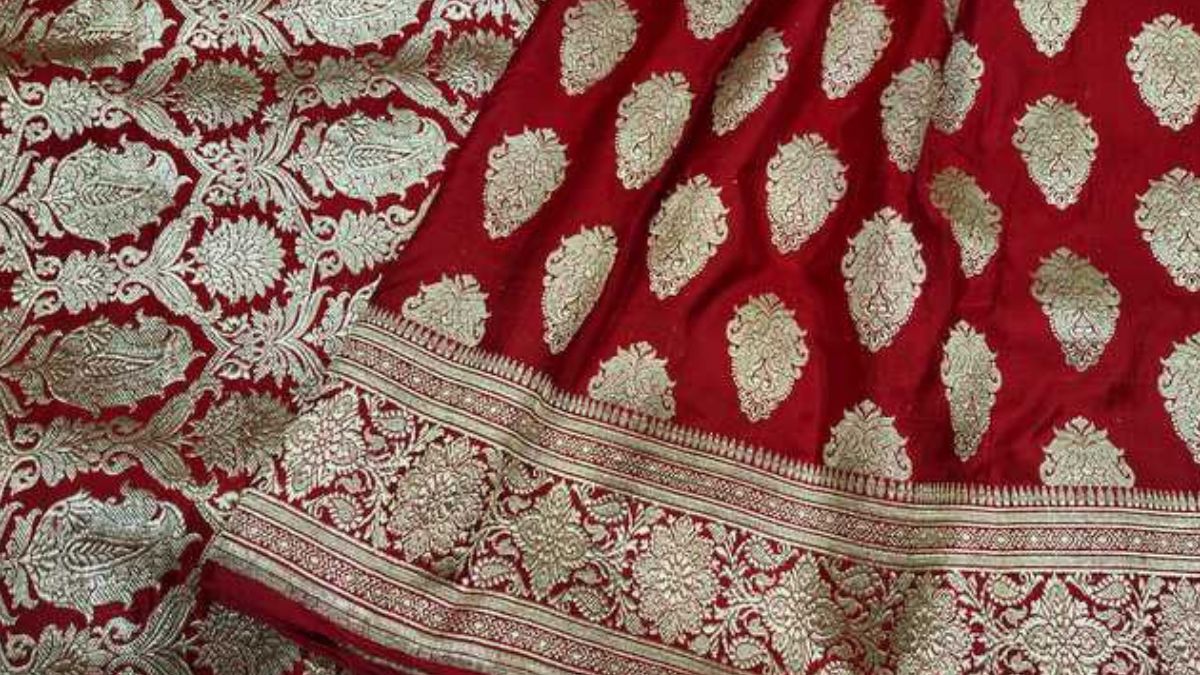
The origin of the Banarasi saree dates back to the Mughal era, around the 14th century. Persian motifs and weaving styles were introduced by Muslim artisans who settled in Varanasi (formerly Benares). These artisans blended Indian craftsmanship with intricate Persian aesthetics, giving birth to the unique style of Banarasi weaving. Over time, the saree became a symbol of opulence and royalty, especially among North Indian aristocracy and brides.
Weaving Techniques of Banarasi Saree: Handloom Craftsmanship and Zari Work
Traditional Banarasi sarees are woven on handlooms using time-consuming, labor-intensive techniques. Each saree can take 15 days to 6 months to complete, depending on the complexity of the design. The weaving incorporates zari, a metallic thread traditionally made of pure silver or gold.
Master weavers use the kadwa technique (where each motif is woven separately) and the phekwa technique (patterned weft is thrown by hand). These processes ensure intricate designs with a rich texture and luxurious finish.
- Banarasi Saree Fabrics: Katan, Organza, Georgette, and Shattir
Banarasi sarees come in various fabrics, each offering a distinct texture and drape: - Katan silk: A pure silk fabric with a soft, lustrous texture. Traditionally used in bridal Banarasi sarees due to its rich appearance and durability.
- Organza (Kora): A lightweight fabric that lends a translucent quality. Banarasi organza sarees often feature delicate zari and resham work.
- Georgette: Originally not part of traditional Banarasi weaving, but now adapted for lighter, modern designs with zari or stone embellishments.
- Shattir: A lesser-known fabric used for contemporary designs. It’s relatively cost-effective and used for experimental patterns.
Traditional Motifs in Banarasi Saree: Mughal-Inspired and Nature-Based Designs
Motifs are a defining feature of Banarasi sarees, with most drawn from Mughal art and nature. Common motifs include:
- Kalga and Bel: Curving floral vines and mango patterns drawn from Mughal gardens.
- Jangla: All-over floral and vegetation motifs woven across the body of the saree.
- Butidar: Tiny floral motifs woven in gold or silver zari against a contrasting base.
- Shikargah: A rare hunting scene motif depicting animals, trees, and hunters in intricate detail.
Each motif carries symbolic meaning and reflects cultural and spiritual heritage.
Types of Banarasi Sarees: Differentiation by Design and Fabric
Banarasi sarees are categorized not only by fabric but also by their design and weaving styles:
- Katan Banarasi Saree: Known for solid color backgrounds with minimalistic or elaborate zari work.
- Jangla Banarasi Saree: Features complex, full-body floral patterns. Often considered one of the most luxurious types.
- Tanchoi Banarasi Saree: Woven with colorful silk threads, often without zari, forming intricate patterns such as paisleys and diamonds.
- Cutwork Banarasi Saree: A more affordable version of Jamdani, with floral motifs achieved by cutting off floating threads after weaving.
- Tissue Banarasi Saree: Has a metallic sheen due to the interweaving of zari with silk threads, making the saree look like it’s made of shimmering gold or silver.
- Identifying an Authentic Banarasi Saree: Key Features and GI Tag
With the rise of machine-made imitations, recognizing an authentic Banarasi saree is crucial: - Look for the handloom irregularities: Authentic Banarasi sarees have slight inconsistencies, especially on the reverse side of the motifs.
- Examine the pallu and border: These sections will always have rich detailing, often with Mughal-style floral or foliate motifs.
- Check for the GI (Geographical Indication) tag: Since 2009, authentic Banarasi sarees from Varanasi carry a GI tag, which guarantees origin and handloom craftsmanship.
- Silk Mark certification: Pure silk Banarasi sarees are often certified with the Silk Mark by the Silk Mark Organization of India.
Bridal and Cultural Significance of Banarasi Saree in Indian Ceremonies
Banarasi sarees are especially popular among North Indian brides, symbolizing tradition, prosperity, and elegance. Red and maroon Katan Banarasi sarees with golden zari are preferred for weddings. Apart from weddings, they are also worn during festivals like Diwali, Durga Puja, and Holi. In Bengali and Bihari cultures, a red Banarasi saree is considered an heirloom passed down through generations.
Maintenance Tips for Banarasi Sarees: Preserve the Weave and Shine
To maintain the quality and longevity of Banarasi sarees:
- Dry clean only: Avoid washing at home to prevent damage to the zari and silk.
- Store wrapped in muslin cloth: This prevents moisture and keeps the zari from oxidizing.
- Avoid direct sunlight exposure: Prolonged exposure can fade colors and dull the fabric.
- Refold periodically: Refolding helps prevent the fabric from tearing along fold lines.
The Banarasi saree is more than a garment — it is a woven narrative of India’s rich cultural history, royal aesthetics, and exceptional craftsmanship. Originating from the looms of Varanasi with deep Mughal influences, each saree tells a story through its fabric, motifs, and meticulous weaving techniques. Whether it’s the luxurious Katan silk, the ethereal organza, or the intricately patterned Tanchoi, every variant holds timeless appeal.
Choosing an authentic Banarasi saree means preserving a piece of India’s handloom legacy. With growing awareness about traditional textiles and the importance of GI tagging, buyers today play an active role in supporting weavers and sustaining this centuries-old art form. Whether draped for weddings, rituals, or celebrations, a Banarasi saree remains a symbol of elegance, heritage, and enduring beauty.
